- Queries in Google Search Console
- Impressions in Google Search Console
- Clicks in Google Search Console
- Average Position in Google Search Console
- Click-Through Rate (CTR) in Google Search Console
- Core Web Vitals in Google Search Console
- Mobile Usability in Google Search Console
- Bonus: Monitoring Page Indexing Status
Understanding how your website performs in the vast landscape of online search is crucial for optimizing its visibility and user experience. Google Search Console serves as a powerful tool, offering valuable insights into various metrics that illuminate the dynamics between your site and its audience. From the specific queries leading users to your pages to the overall impressions, clicks, and user engagement, these metrics provide a comprehensive overview of your website's performance. Let's see on the top 7 key metrics that Google Search Console offers, each shedding light on different aspects of your site's presence and functionality.
- Queries: This metric shows how Google perceives your site, including the keywords you rank for and the search queries that lead to your site.
- Impressions: This metric shows the number of times your site appears in search results.
- Clicks: This metric shows the number of times users click on your site from search results.
- Average Position: This metric shows the average position of your site in search results for the keywords you rank for.
- Click-Through Rate (CTR): This metric shows the percentage of users who click on your site from search results.
- Core Web Vitals: This metric measures the performance of your site's loading speed, responsiveness, and visual stability.
- Mobile Usability: This metric shows any issues with your site's mobile usability, such as slow loading times or unresponsive design.
These metrics provide valuable insights into your website's performance, helping you identify areas for improvement and track your progress over time.
Queries in Google Search Console
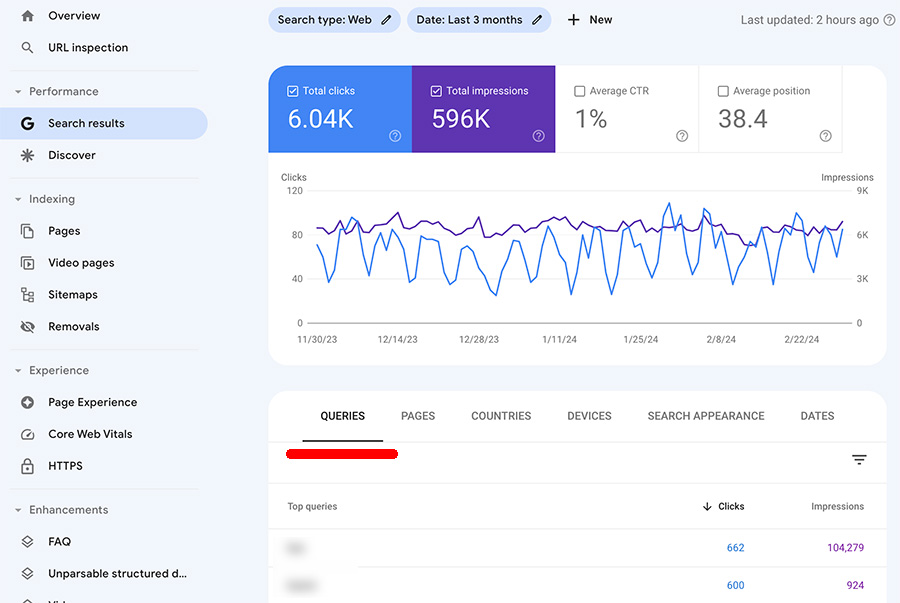
Queries in Google Search Console refer to the search terms or keywords that users enter into Google Search that lead to impressions and clicks on your website. This metric provides valuable insights into how users find your site and what keywords are driving traffic. By analyzing queries data, website owners can assess the effectiveness of their keyword strategy and identify opportunities for improvement.
The "Number of top 1000 Queries on Position Group" metric in Google Search Console shows the average position on Google search results for each query that led to clicks on your website.
This metric helps you understand where your site ranks for specific queries and how this impacts user engagement.
Queries data is crucial for evaluating the performance of your website in search results. It allows you to see which keywords are driving traffic, how users interact with your site based on different queries, and helps you optimize your content for better visibility and relevance
In Google Search Console, the Queries metric is part of the Performance report, which provides important insights into how your site performs in Google Search results over time. It allows you to track changes in search traffic, understand where your traffic is coming from, and identify which search queries are most likely to show your site
Analyzing Queries data can help you gauge the effectiveness of your keywording strategy, track the performance of specific keywords over time, and identify missed opportunities for improving your site's visibility and relevance in search results
Overall, Queries in Google Search Console play a vital role in understanding user behavior, optimizing content for search engines, and improving the overall performance of your website in organic search results.
Impressions in Google Search Console
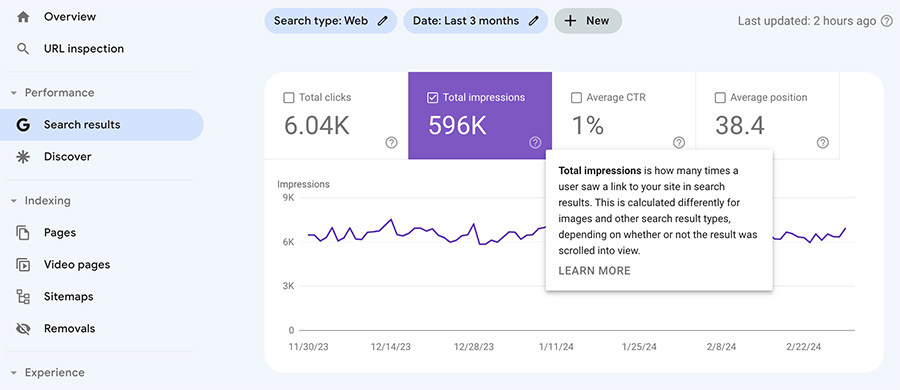
Impressions in Google Search Console refer to the number of times a URL from your website has appeared in Google's search results, regardless of whether it was clicked or not. This metric helps you understand how often your site is being seen by users in search results. It is a crucial metric for measuring the visibility of your website and the effectiveness of your SEO efforts.
Impressions are counted when a URL is displayed in a Google search result, whether it is a plain blue link, a featured snippet, or any other type of result. The number of impressions can vary depending on factors such as the position of the URL in the search results, the type of search result, and the user's interaction with the search results page.
In Google Search Console, impressions are part of the Performance report, which provides insights into how your site performs in Google Search results over time. By analyzing impressions data, you can identify which keywords and pages are driving traffic to your site, and make informed decisions about optimizing your content and improving your site's visibility in search results.
Clicks in Google Search Console
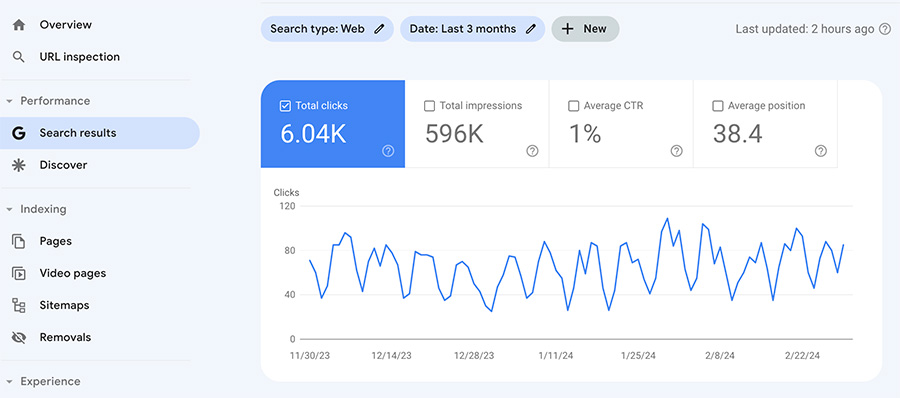
Clicks in Google Search Console represent the number of times users have clicked on a link to your website from Google search results. It is a crucial metric that indicates user engagement and the effectiveness of your website's visibility in search results. Clicks are counted when a user clicks on a search result that leads them to a page outside of Google Search, Discover, or News. Clicking on a link that stays within the Google platform is not counted as a click.
Understanding the number of clicks your website receives from Google search results is essential for evaluating the performance of your SEO strategy and assessing how well your content resonates with users. Clicks data helps you measure the impact of your website's visibility in search results and track the effectiveness of your SEO efforts in driving traffic to your site.
In Google Search Console, clicks are part of the Performance report, which provides detailed insights into how users interact with links to your site in Google Search, News, and Discover. By analyzing clicks data, you can identify which pages are attracting the most clicks, evaluate the performance of specific keywords, and optimize your content to improve click-through rates.
Overall, clicks in Google Search Console play a vital role in understanding user behavior, measuring the success of your SEO efforts, and making informed decisions to enhance the visibility and performance of your website in organic search results.
Average Position in Google Search Console
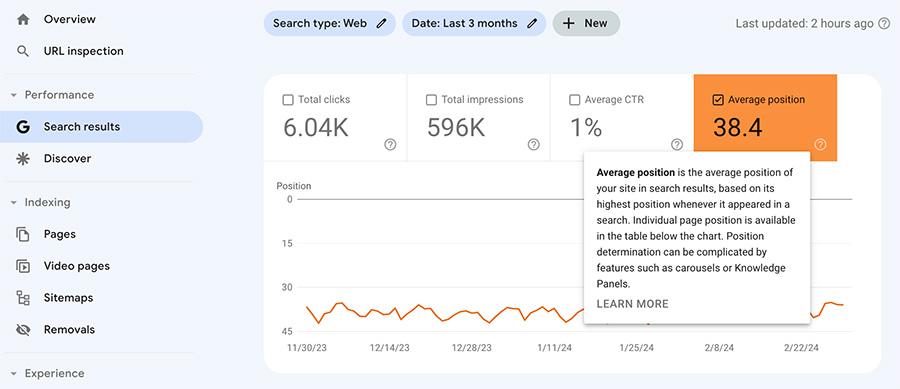
The average position in Google Search Console is a metric that indicates the average rank of your website in the Search Engine Result Pages (SERPs) for a specific time period. It provides insights into where your website typically appears in search results for the keywords you rank for. This metric is crucial for understanding your website's visibility and performance in organic search results.
When analyzing the average position metric, it's important to consider that Google calculates this value based on the topmost position of a URL from your site that appears in search results. If multiple URLs from your website are displayed, Google uses the highest ranking URL to calculate the average position. Factors like personalization, geo-targeting, and short-lived visibility can influence the discrepancy between the average position reported in Google Search Console and what site owners observe when checking their rankings.
A lower average position generally indicates better visibility, as it signifies that your website is appearing higher in search results for relevant queries. Achieving an average position of 10 or lower is considered favorable, indicating that your website ranks on the first page for most or all of your keywords.
However, it's essential to focus on optimizing your website for user intent, providing valuable content, and implementing a holistic SEO strategy rather than fixating solely on achieving a specific average position.
In summary, the average position metric in Google Search Console offers valuable insights into your website's performance in search results. It should be viewed as part of a larger SEO strategy that considers various factors influencing search visibility and user engagement. Monitoring trends in average position, along with other key metrics like clicks, impressions, and click-through rate, can help you make informed decisions to enhance your SEO efforts and improve your website's overall performance.
Click-Through Rate (CTR) in Google Search Console
Click-through rate (CTR) is a metric that measures the percentage of users who click on a link to your website from Google search results. It is calculated by dividing the number of clicks by the number of impressions (times your site's listing appeared in search results). A high CTR indicates that your website's content and meta information are appealing to users, enticing them to click on your site's link.
In Google Search Console, CTR is a key metric that helps you understand how well your website's search engine ranking is attracting users to click on your site's link based on its visibility in search engine results pages (SERPs). A high CTR can lead to increased organic traffic and better search engine rankings.
To improve your CTR, you can optimize your website's title tags, meta descriptions, and content to make it more relevant and engaging to users. Additionally, you can use structured data to enhance your search snippets and make your website more attractive to users. Regularly monitoring and analyzing your CTR in Google Search Console can help you identify trends, spot issues, and track the effectiveness of your optimization efforts.
Core Web Vitals in Google Search Console
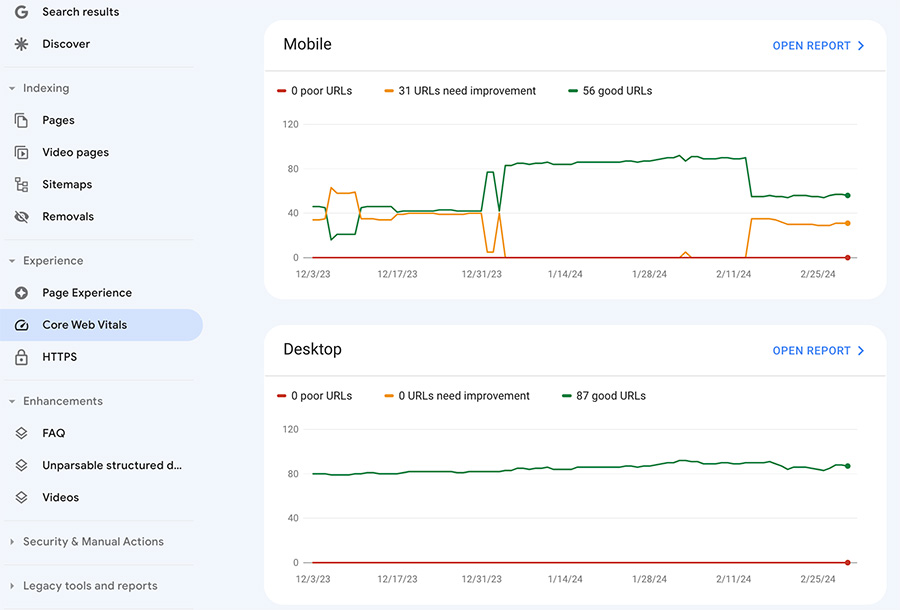
Core Web Vitals are a set of three metrics that measure the speed, interactivity, and visual stability of a webpage. They are considered important ranking factors for search engine optimization (SEO) and can help improve a website's overall user experience. The three Core Web Vitals are:
- Largest Contentful Paint (LCP): This measures how long it takes for the largest content element on a page to load. A good LCP score is when the largest content element loads within 2.5 seconds.
- First Input Delay (FID): This measures the time from when a user first interacts with a page (e.g., clicking a link or tapping a button) to when the browser responds to that interaction. A good FID score is less than 100 milliseconds.
- Cumulative Layout Shift (CLS): This measures the visual stability of a page by tracking how often users experience unexpected layout shifts. A good CLS score is less than 0.1.
You can find your site's Core Web Vitals data in the "enhancements" section of your Google Search Console account. Monitoring and improving your Core Web Vitals can help your website rank higher in search results and provide a better user experience.
Mobile Usability in Google Search Console
Mobile usability in Google Search Console refers to the assessment of how well a website performs and functions on mobile devices. It focuses on ensuring that websites are user-friendly, responsive, and provide a seamless experience for visitors accessing the site from smartphones or tablets.
Google recognizes the significance of mobile usability due to the increasing number of users browsing the internet on mobile devices.
When Google identifies mobile usability issues on a website through Search Console, it indicates that there are aspects of the site that may hinder user experience on mobile devices. These issues can range from design flaws to functionality problems that could impact how well the site performs in mobile search results.
To address mobile usability issues, website owners are advised to test their fixes across various mobile devices to ensure an improved user experience. Implementing a responsive design for the website is recommended as it automatically adjusts the layout based on the screen size of the device, helping prevent many common mobile usability issues.
While Google has retired the Mobile Usability report, Mobile-Friendly Test tool, and Mobile-Friendly Test API, emphasizing other resources like Lighthouse from Chrome for evaluating mobile usability, ensuring that websites are mobile-friendly remains crucial for success in Google Search. Maintaining a mobile-friendly website is essential as a significant portion of internet users access websites through mobile devices.
Bonus: Monitoring Page Indexing Status
Including information about the ability to check the index status of pages in Google Search Console is crucial for website owners. Monitoring the indexing status of pages is essential for ensuring that your content is being properly crawled and included in Google's search index. By regularly checking the index status, website owners can identify any potential issues that may prevent their pages from appearing in search results.
Website owners can use the URL Inspection tool in Google Search Console to check the index status of individual pages. This tool provides detailed information about whether a specific page is indexed by Google or not. If a page is not indexed, website owners can investigate the reasons behind it, such as crawling errors, noindex tags, or other technical issues that may be hindering indexing.
Having the ability to check the index status of pages allows website owners to troubleshoot and resolve any indexing issues promptly. Ensuring that all important pages are indexed is crucial for maximizing organic search visibility and driving traffic to the website. By addressing any indexing issues, website owners can improve their site's overall performance in search results and enhance its online presence.
In conclusion, the ability to check the index status of pages in Google Search Console empowers website owners to maintain a healthy and well-indexed website. It enables them to proactively address any indexing issues, optimize their content for search engines, and ensure that their website is effectively represented in Google's search results.
